Dog Days (I)
In acknowledgement of the 2018 Wuxu Year of the Dog, which we ushered in with the essay Mondo Cane on Lunar New Year’s Day (the 16th of February), China Heritage is publishing ‘Dog Days’, a series of canine-themed articles, essays, translations and art works.
Dog Days — a calque of the Latin dies caniculares — refers to the hot and sultry days at the height of summer. Even in these early years of precipitous global warming, however, Dog Days are something that still lies in the future for those celebrating Spring Festival (or what vocal patriots in the People’s Republic of China demand be called ‘Chinese New Year’) in East Asia; here in the southern hemisphere it is the height of summer and we mark the fact with our Dog Days.
In Chinese the hot season is referred to as sānfútiān 三伏天, three ten-day periods of debilitating heat. It is believed that the word fú 伏, ‘prostrate’, also relates to the dog, especially as the character 伏 consists of a single-man radical 單人旁 and the word for dog quân 犬. As Victor Mair notes in his discussion of Chinese characters, myths, dogs and dog-humans:
In China, the dog days are called futian 伏天 or sanfutian 三伏天. These are the three ten-day periods of the hot season. They are roughly equivalent to the period from the middle of July to the latter part of August. We should note that, in Roman times, the six or eight hottest weeks of summer (usually falling in July, August, and early September) were known colloquially as dies caniculares (‘days of the dog’). This usage originated with the Greeks, Romans, and Egyptians. The main reason the dog days were called such (aside from the empathy of sweltering humans with furry, tongue-hanging-out canines suffering under the blistering sun) was because it was thought that the dog star Sirius added its heat to that of the sun during this period (roughly July 3-August 11 as reckoned astronomically [when Sirius’ rise coincides with that of the sun]). Sirius, located in the constellation Canis Major (‘Bigger Dog’), is the most brilliant star in the sky. Its Latin name derives from Greek Seirios, which means ‘burning’. It is also called the Dog Star, Sothis, from Egyptian spdt.
— Victor C. Mair, Canine Conundrums:
Eurasian Dog Ancestor Myths in
Historical and Ethnic Perspective,
Sino-Platonic Papers,
No.87 (October 1998): 25
***
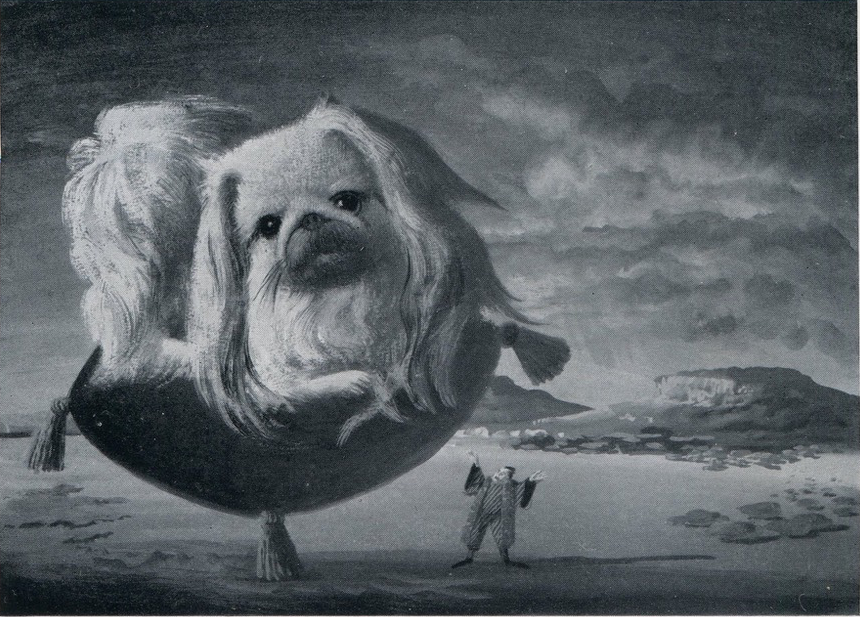
Dog Days is a continuation of New Sinology Jottings 後漢學劄記, a China Heritage series inaugurated at the start of the Year of the Rooster in 2017. We mark this first Dog Day with an essay by Don J. Cohn, bibliophile, collector and Peke-obsessive.
Don studied Chinese at Oberlin College and Columbia University. He lived and worked in Beijing, Hong Kong and Taiwan, including a period as an associate editor at Renditions magazine at the Chinese University of Hong Kong and as books editor at Far Eastern Economic Review. Don and I worked at Renditions at the invitation of the editor and literary translator John Minford (co-founder in 2016 of the Wairarapa Academy for New Sinology). With John we produced, among other things, Seeds of Fire: Chinese Voices of Conscience (1986).
Since 1979, Don Cohn has organised and led over 175 specialist and other tours to China; written, translated and edited books and articles on subjects of Chinese interest, and he remains acitve buying and selling printed matter from China and Japan.
As a New York native and owner of five Pekingese we expect that Don would appreciate Groucho Marx’s observation, ‘Outside of a dog, a book is a man’s best friend. Inside of a dog, it’s too dark to read.’
— Geremie R. Barmé,
Editor, China Heritage
Third Day of the
First Month of 2018
Wuxu Year of the Dog
戊戌狗年正月初三
18 February 2018
***
Further Reading:
- Don J. Cohn, A Bibliophile in Sin, China Heritage Quarterly, Issue 10 (December 2009)
- The Editor, Mondo Cane, The Year of the Dog 2018 戊戌狗年, China Heritage, 16 February 2018
- Don J. Cohn, A Pride of Pekingese — Dog Days (I), China Heritage, 18 February 2018
- Pu Songling, The Dog Lover — Dog Days (II), China Heritage, 24 February 2018
A Pride of Pekingese
Bite Foreign Devils Instantly
Don J. Cohn
I can think of no better way of introducing these notes on the Pekingese dog than by quoting the Empress Dowager Cixi (慈禧, 1835-1908) of the Qing dynasty:
Pearls Dropped from the Lips of
Her Imperial Majesty Tzu-Hsi
Dowager Empress of the Flowery Land
- Let the Lion Dog be small; let it wear the swelling cape of dignity around its neck; let it display the billowing standard of pomp above its back.
- Let its face be black; let its forefront be shaggy; let its forehead be straight and low.
- Let its eyes be large and luminous; let its ears be set like the sails of war junk; let its nose be like that of the monkey god of the Hindus.
- Let its forelegs be bent; so that it shall not desire to wander far, or leave the Imperial precincts.
- Let its body be shaped like that of a hunting lion spying for its prey.
- Let its feet be tufted with plentiful hair that its footfall may be soundless and for its standard of pomp let it rival the whisk of the Tibetans’ yak, which is flourished to protect the imperial litter from flying insects.
- Let it be lively that it may afford entertainment by its gambols; let it be timid that it may not involve itself in danger; let it be domestic in its habits that it may live in amity with the other beasts, fishes or birds that find protection in the Imperial Palace.
- And for its color, let it be that of the lion — a golden sable, to be carried in the sleeve of a yellow robe; or the colour of a red bear, or a black and white bear, or striped like a dragon, so that there may be dogs appropriate to every costume in the Imperial wardrobe.
- Let it venerate its ancestors and deposit offerings in the canine cemetery of the Forbidden City on each new moon.
- Let it comport itself with dignity; let it learn to bite the foreign devils instantly.
- Let it be dainty in its food so that it shall be known as an Imperial dog by its fastidiousness; sharks fins and curlew livers and the breasts of quails, on these may it be fed; and for drink give it the tea that is brewed from the spring buds of the shrub that groweth in the province of Hankow, or the milk of the antelopes that pasture in the Imperial parks.
Thus shall it preserve its integrity and self-respect; and for the day of sickness let it be anointed with the clarified fat of the legs of a sacred leopard, and give it to drink a throstle’s [song thrush] eggshell full of the juice of the custard apple in which has been dissolved three pinches of shredded rhinoceros horn, and apply it to piebald leeches.
So shall it remain — but if it dies, remember thou too art mortal.[1]
It is far from certain whether this winsome list of ‘Peke Desiderata’ was actually formulated by the empress dowager. Regardless, it has inspired generations of Pekingese fanciers, bestowing on the breed an instant imperial pedigree in grandiloquent, faux-regal tones, conferring shamanic powers on the creature’s physical attributes and comparing its comportment and behavior to that of a court official. It is said that in the Tang dynasty (eighth century) some palace dogs — presumably ancestors of Qing-era Pekingese — were even granted official rank at court, along with the attendant privileges.
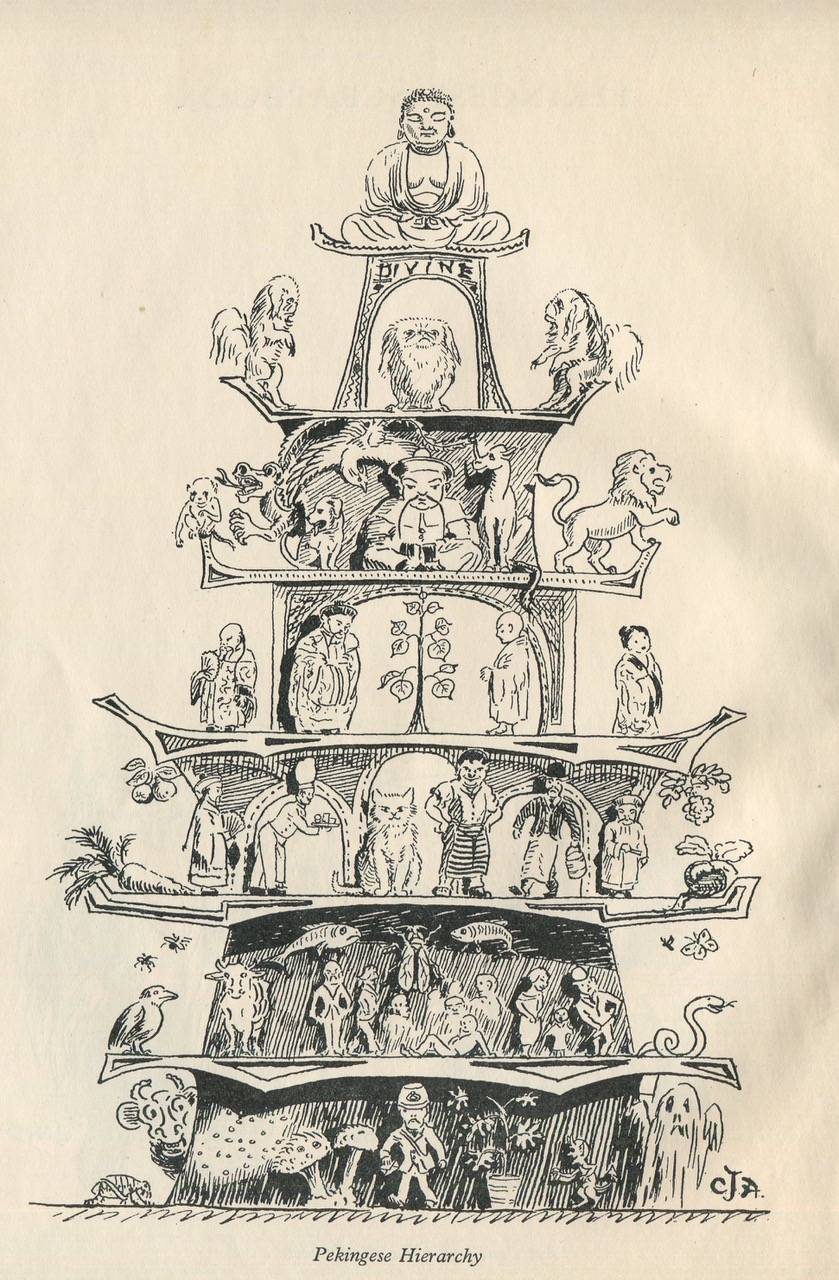
***
The author’s affair with Pekingese was an accident, although I would suggest it was pre-ordained. Like many students of China, I became enamored of Pekingalia, fascinated by Pekingology, and even had the good fortune to live and work in Beijing from 1981 to 1984. I have visited the city frequently ever since. In 2001, upon returning to my home in Chek Nai Ping in Hong Kong’s New Territories from a China trip, my amah Julie said, ‘Sir, I have something to show you. I don’t know if you will like it or not.’
She opened a cardboard box in her bedroom to reveal a Pekingese. Julie told me she had found it abandoned in a shoebox at our garbage disposal point. After a mandatory wait of two weeks, the Hong Kong Agriculture and Fisheries department informed me that, as no one had claimed her, the dog was mine. I decided to call her Doufugan 豆腐乾. She wore a camel-coloured coat, with white paws (colloquially known as ‘standing in snow’ 雪裏站) and was possessed of an iconic, no-nose black face. Like the soybean product after which she was named, Doufugan was compact, chewy and delectable. She was about five months old. Doufugan taught me that fate, or preordained karmic connections 緣分, were no fantasy.
My upstairs neighbours in the Hakka village of Chek Nai Ping, who enjoyed caring for her on Sunday mornings, called her 天真, ‘The Innocent One’. It suited her well enough until, several years later, she bore four puppies in Tokyo by an American champion stud called Tarzan Rule the Jungle. The litter consisted of: Mantou 饅頭, Doufuhua 豆腐華, Goma 芝麻 and Pidan 皮蛋, the latter the sole female. I chose these names — literally Steamed Bread, Beancurd Cathay (a pun on soybean pudding), Sesame Seed [Japanese] and Thousand-year-old Egg, respectively — for their Chinese resonances and because they are foods that I love, with characteristic flavours and textures that can be readily discovered both abstractly and concretely in one’s canine bedmates.
Doufugan died in my arms at the age of thirteen; Mantou succumbed to a congenital kidney disorder at seven; a third generation is now anticipated, mating alpha Hua with a recently purchased black pedigree bitch, Ku Ku, named after an early twentieth-century champion, Ku Ku of Yam. (Pidan was spayed to prevent close inbreeding.) The first union was unsuccessful.
***

Much has been written in English about the Pekingese since the first dogs arrived in England after the sacking of the Yuanming Yuan 圓明園, or Garden of Perfect Brightness, in 1860. The breed became the most popular in England in the early twentieth century. It is not my intention to rewrite this history, one which has been told many times and in many confusing ways; nor do I have anything particular to add to the various mystical tales about or zoological speculations concerning the origins of the dog — legend has it, for example, that the Pekingese is the love child of a lion and a marmoset. There is also much controversial writing about the connection between the Peke and the stone, bronze, and jade dog images that fill museums and guard the front gates of palaces, temples and grand residences in China. For example, the female lion-dog in a pair of guardians often appears with her paws in the mouth of a recumbent puppy. This is explained in two ways: that the mother is nursing her offspring through her paw; or, that the large dog stands for China, and the tiny one for Japan.
The history of the Peke is one that is also filled with lurid and fanciful notions: Pekes were nursed by palace slave girls; their noses were massaged to flatness; meat was hung on the wall out of their reach in such a way that every time they leaped for it they bumped their noses ‘into shape’; a barking Pekingese proceeded the emperor when he strolled into an audience hall, while other Pekes held the train of his robe in their mouths — regardless of whether imperial Chinese robes even had trains.
There are no reliable extant Chinese sources on the evolution of the Pekinese from ancient times to the twentieth century, save for incidental citations related to the supposedly courageous exploits of a smattering of intelligent, small dogs that date back as far back as the Tang dynasty. And, while some authors, as recently as a few in the 1950s, claim that examples of the breed have been the faithful companions of Chinese emperors for the past two thousand years, today’s Pekinese appear to be a product of the eighteenth century, and like all dogs they are the result of a complex blending, with genes from animals in Tibet and Manchuria, along with a possible early infusion of DNA from the European Maltese via Persia. Since dogs reproduce as early as the age of two or three, canine breeds can be created in the space of a few of decades.

The word ‘Pekingese’ or ‘Pekinese’ is not a translation from Chinese. And the Chinese terms 北京犬 or 京巴狗 do not necessarily denote the Peke. Rather ‘Pekingese’ is an English term for the Manchu palace specimens taken from Beijing in the mid-nineteenth century. The term habagou 哈巴狗 — a name that is perhaps of Manchu or Turkish origin (after Berthold Laufer) does not necessarily refer to the iconic creature described by Cixi that flourished in the nineteenth century. In fact, it may be a general term for small dogs (it is the modern Chinese word for pug), even if it was in currency in the palaces of the Qing rulers. Haba has been explained variously as meaning ‘under the table’, indicating therefore a dogs’ diminutive size, or as a reference to the short-legged animal’s swaggering, swanking, swaying gait. Thus, from the available evidence, it would seem that ‘Pekinese’ is an term of imperialist invention, just are other internationally recognised Chinese icons: The Great Wall, The Silk Road, The Forbidden City, and, of course, The Summer Palace (even though the Yuanming Yuan was not, in fact, a summer palace).
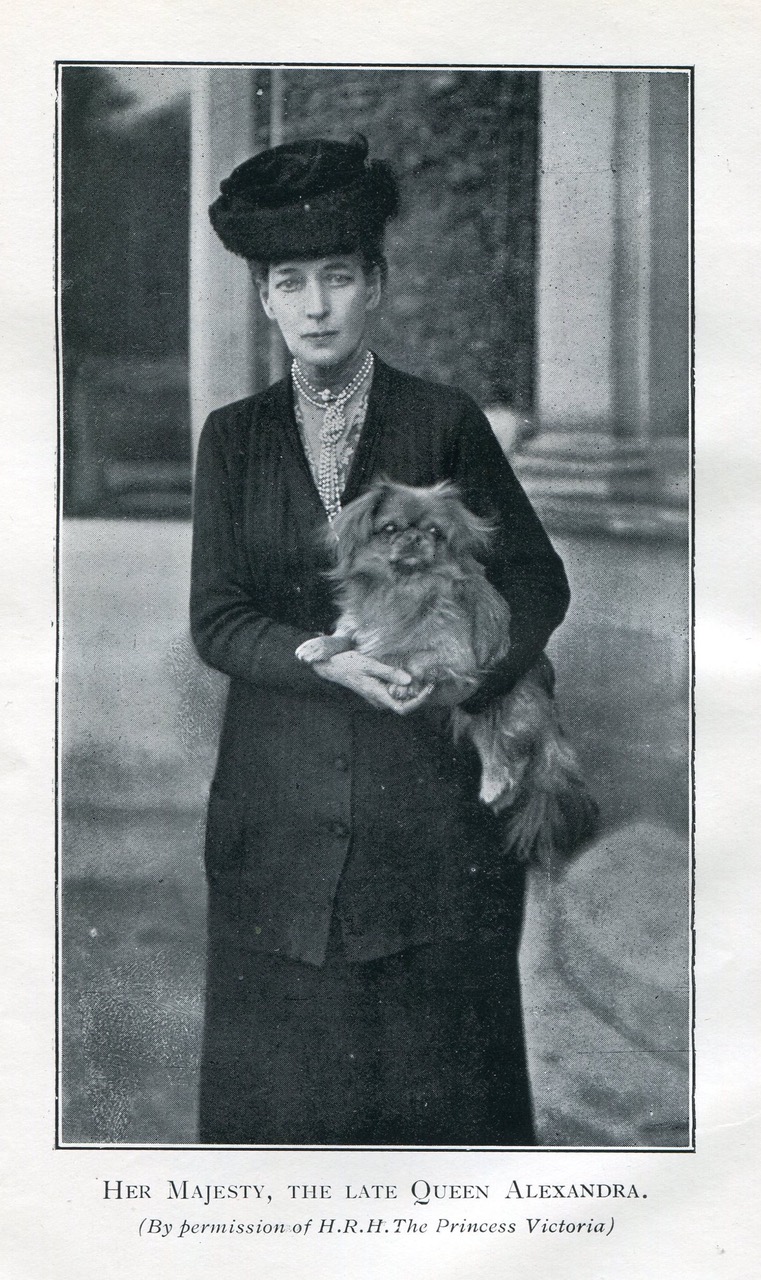
The role that the Pekingese subsequently played in class-conscious British society, including the royal family, during the Peke’s prominence on ‘bench and kennel’ over several decades is recounted by Sarah Cheang in ‘Women, Pets, and Imperialism: The British Pekingese Dog and Nostalgia for Old China’ (Journal of British Studies, 45(2) [2006]: 359-387). The elaborate and earnest cultivation of the Pekingese in the late-nineteenth and early twentieth centuries, coincidental with the British Empire at its ‘peak’, saw a revival of various forms of Chinoiserie. English women and men dressed up in ex-imperial Chinese robes and raised aristocratic Chinese dogs, playing as it were house with the Forbidden City itself as dollhouse; we might call this ‘gilt by association’.
By 1910, the United Kingdom boasted some six hundred kennels that bred Pekingese, most of them run by women.
***
One wonders why the Pekingese, as a possibly prime exemplar of China’s vaunted ‘national essence’ 國粹, has not been enlisted as part of New China’s projection of soft power and diplomacy, unlike the panda, which offers the ultimate mien of Chinese feel-good globalism. Perhaps the taint of Manchu decadence is too great. Under an earlier regime, Empress Dowager Cixi’s gifts of Pekes to British and American visitors and diplomats contributed significantly to the hubbub that percolated around the dogs, their mysterious origins, ancient lineage and trueness to type, as well as playing up to the aspirations of their owners.
Unlike pandas, Pekes are anything but an endangered species; indeed, commercial overbreeding brought an end to a brief resurgence of the Pekingese in China itself in the 1990s, when rare breeds like the chow-chow 鬆獅犬 and Tibetan mastiff 藏獒 became the costly appurtenance of conspicuous Chinese consumption; they, too, went the way of tulips. Seeking to learn about the state of the breed in its place of origin, in 2005 I visited an outdoor Beijing dog market in Tongzhou east of the city. By that time, not a single animal trader handled Pekes. Upon inquiring I was told that there were simply ‘Too many!’ 太多了! Overbreeding and inbreeding, without sufficient cross-breeding to reinforce positive traits had spoiled their seductive charm, in China as elsewhere. The Communist Department of Propaganda has unfortunately missed an opportunity: Imagine what international prestige, and Cuddle Power, could be derived from a Peke named, say, Dangdang of Zhongnanhai 中南海黨黨 winning Best of Show at the American Kennel Club or Crufts.
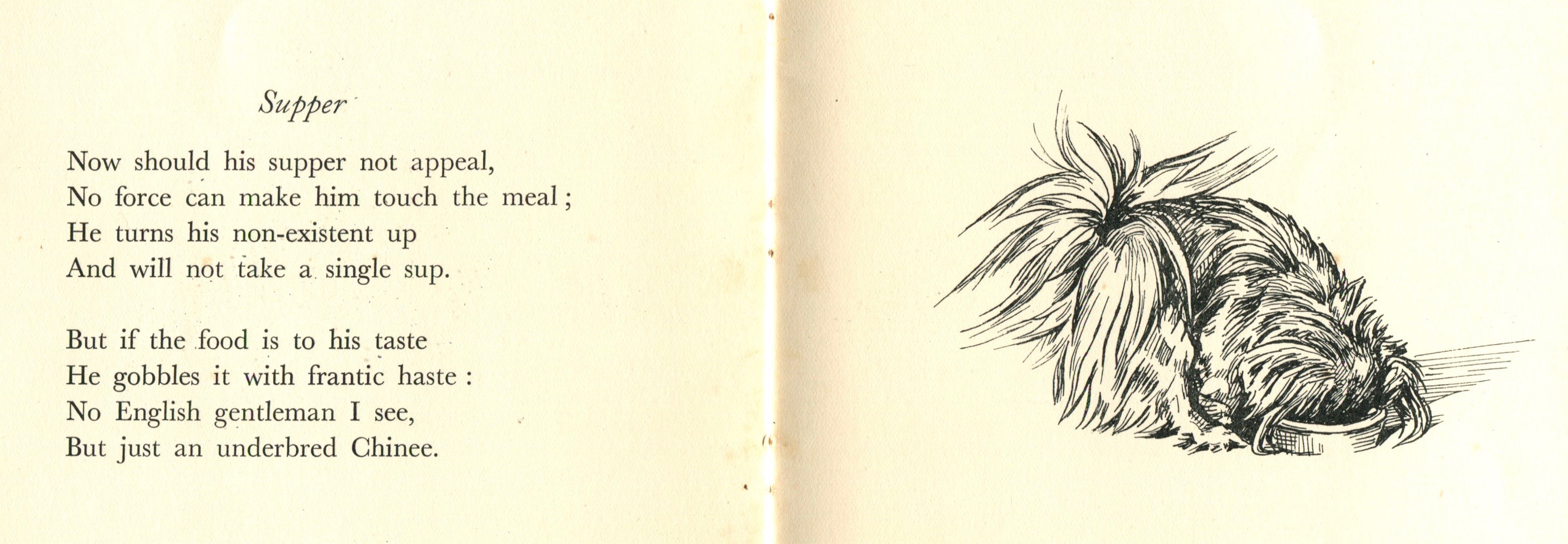
While their lustre may have worn thin in China, in the West Pekes have basked in the limelight, despite being the ninety-third most popular breed in the United States in 2016.
In 2011, Palacegarden Malachy, born 24 January, 2008, won Best in Breed and Best Toy in the prestigious American Kennel Club show, and was the second ranked dog in the US that year. In 2012, Malachy won Best in Show at the AKC event in New York, as well as the Best in Breed and Best Toy categories. But this leap to fame hardly improved the breed’s popularity. Critics decried Malachy as a ‘troll doll’, a ‘dust mop’, and a ‘handlebar moustache’, among other things. While the Best in Show title came with a silver cup (although no cash prize), garnering the honour confers upon a dog and its kennel (in this case, Pequest) immense prestige, as well as resulting in a waiting list of bitches in heat, who must be vetted for pedigree before insemination, artificial in the case of champion Pekes. Just in case, the semen of champion dogs is usually frozen, thereby granting a degree of immortality to the line.
Pekingese are no small beer in the US; there is even a magazine devoted to the breed in Florida titled Orient Express. It is a publication that is overflowing with Peke-related obsessions.
***
Given the fanciful embroidery woven around the Pekingese, it was refreshing to discover a sober comment about the breed, published in the last year of the Qing dynasty: ‘The tendency of modern writers is to surround the Pekingese with an atmosphere of what I can only call romantic nonsense. It would, I think, be best to divest ourselves of a sentimentality which only misleads us’. As for the antiquity attributed to this breed, the same author concludes: ‘I will stake my life that no Chinese dog that ever lived was like the ancient Chinese monsters seen in museums.’ [2]
Not only is there nothing monstrous about the Pekingese, but fanciers of the breed insist that among dogs Pekes most closely resemble the homo sapien. A person once bitten, or piqued by the Pekingese bug 蟲兒 (as they were referred to colloquially due to their resemblance to fluffy caterpillars), will always come back for more.
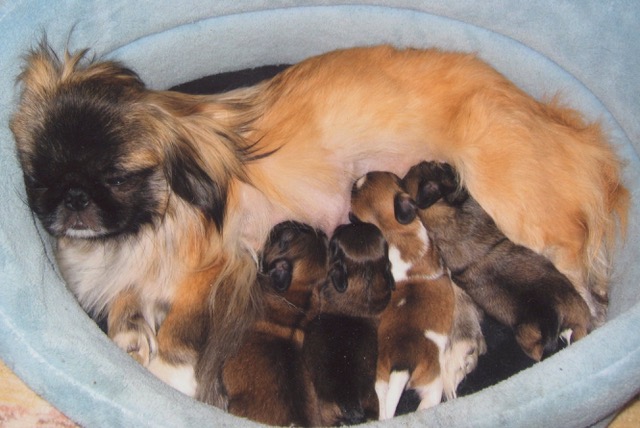
Notes
[1] These ‘points’ appear repeatedly in dog books from the 1920s to the present day. There seems to be no Chinese original, by any hand. One might even suggest that the ‘Dowager’s Desiderata’ are a Western confabulation.
[2] See Mrs. Neville Lytton, Toy Dogs and Their Ancestors: Including the History and Management of Toy Spaniels, Pekinese, Japanese, and Pomeranians, New York: D. Appleton, 1911, p.253, cited by Sarah Cheang.

